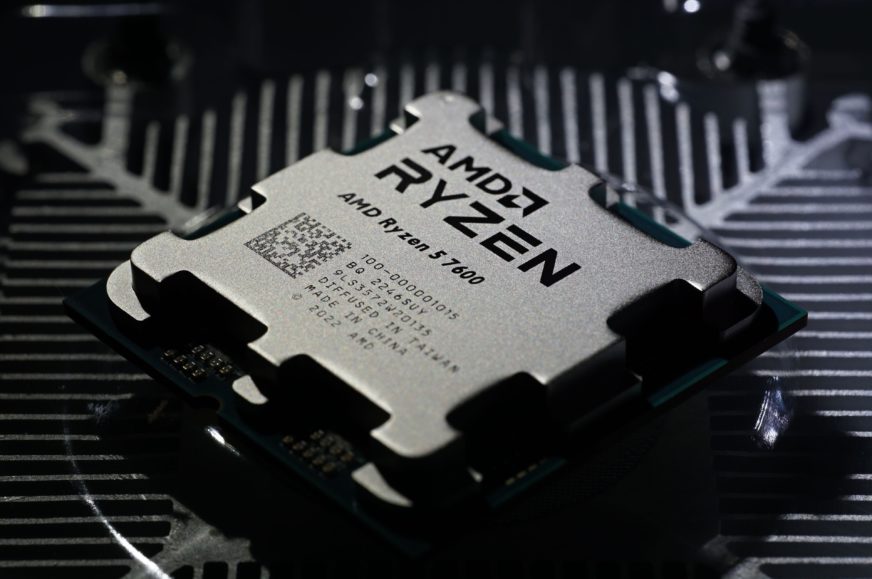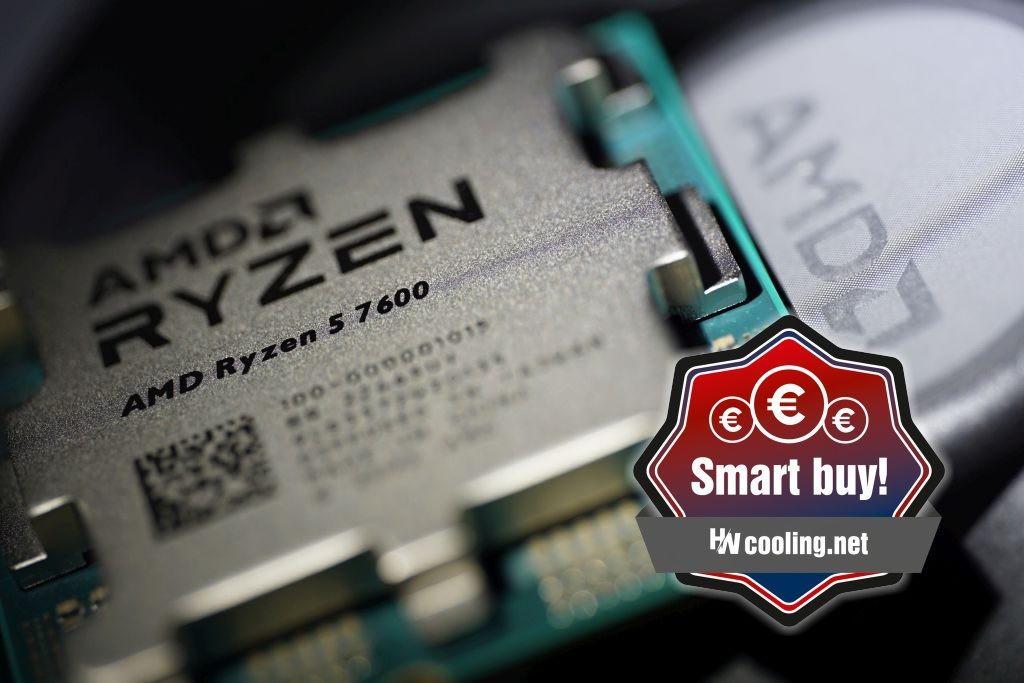Conclusion
This time, it wasn’t as long a wait as for the Ryzen 5 5600. On the contrary, the Ryzen 5 7600 came out very shortly after the faster model with the “X” in the name. AMD apparently hurried with this lower-power model also because of dissatisfied reactions that 7600X criticize the worse cooling. With the significantly more efficient R5 7600, the situation with silicon is brighter. Plus it’s cheaper and doesn’t lose all that much in performance.
Conclusion
We’ll start our evaluation with the chapter that tends to be the most popular in processor tests – overall gaming performance. The latter is only just below the Core i5-13600K on the Ryzen 5 7600. More attractive, of course, will be the forthcoming comparison with the Ci5-13400(F). The lead of the R5 7600 over the Ci5-12400(F) is quite significant. This is especially so for the more conservative clock speeds (Ci5-12400). The more aggressively clocked Ryzen 5 7600X naturally performs better, albeit at the cost of higher power draw, even during gaming, roughly by 10–15 W. The gaming performance per unit of power draw of Ryzen 5 7600 (i.e. the lower-power variant without the X in the designation) is the highest of the tested processors so far, and it narrowly, but nevertheless, outperforms the extremely efficient Comet Lake Core i5-10400F.
Of the specific games, only Assassin’s Creed: Valhalla (where the Ryzens don’t “do” very well overall) has weaker performance. In the other titles tested, the results are average (Cyberpunk 2077, DOOM Eternal) to above average (Borderlands 3, CS:GO, F1 2020, Metro Exodus, Microsoft Flight Simulator, Shadow of the Tomb Raider, Total War Saga: Troy). The price to gaming performance ratio is about 5% weaker, but with the Ryzen 5 7600 being the significantly more powerful processor for a gaming PC of the pair.
On raw, computing power: the R5 7600 is 6 % below the R5 7600X, but 25 % above the Core i5-12400. You will find out how it stands up in the most relevant comparison with the Ci5-13400(F) in one of the following tests. In any case, the efficiency of the R5 7600 is very high, higher than that of the Ci5-12400, it is the most efficient 6-core processor we have tested so far.
By maintaining high clock speeds in a single-threaded workload, the R5 7600 delivers true peak performance (Also seen in PCMark office tasks or in application tests in a web interface). It’s approximately on par with the Core i9-12900K, and at significantly higher efficiency. The power draw of the R5 7600 is about half. The Ryzen 5 7600X is a hair faster in single-threaded workloads due to higher clock speeds, and it also has a bit higher power draw.
Remarkably, while idle, the R5 7600 is a relatively high 5W (27%) more power efficient compared to the R5 7600X. This can be due to a number of reasons. One is higher manufacturing tolerances with lower quality requirements (for the R5 7600) and the other is the higher Uncore clock speeds that boards with slower memories set. Here’s a reminder to part of the methodology – we’re testing the more lower-power processors (without the X/K in the designation) with the cheaper DDR5 modules (5200 MHz/CL40), and the more powerful ones with the more expensive ones at 6000 MHz and CL30. This way it is closer to real practice, but the toll is the eventual distortions that sometimes have to be perceived when directly comparing X and non-X processors. If you are comparing only X and only non-X processor models with each other, the playing field is completely level.
When studying and assessing the minimal differences, beware of other people’s tests, where different memory configurations (across platforms with support for different standards, for sure) also occur. We try to optimize everything to make the most sense. Hence slower (and cheaper) memory to cheaper processors and faster memory to more expensive ones.
It should also be pointed out that we have tested the Core i5-12400, for example, with 3600 MHz DDR4 memory (Gear 1) and, naturally, also older AMD Ryzen 5000 and 3000 processors, whose memory controller does not support DDR5 modules. All these details are also listed in the pop-up window that appears when the cursor hits the corresponding processor bar. However, the differences in performance across these modules are often minimal and sometimes don’t even show up, so there is no need to give them more weight than they really have.
Lastly, temperatures. These are proportional to the lower power draw compared to the R5 7600X, but temperatures climb quite high even with a powerful cooler. All the performance is still on a small area of a single chiplet, and unless you limit the processor to the TDP level, clock speeds above 5 GHz are achieved even under high load. The important thing is that you can keep the processor below 95°C under almost any circumstances, even with a cheaper or very quiet cooler. Power draw in games is significantly lower compared to the maximum load, by 35–40 W, and with a medium-performance cooler you can comfortably fit even below 60 °C, and the included Wraith Stealth top-flow cooler is also usable, albeit at higher noise levels.
AMD has balanced all aspects well with Ryzen 5 7600 (performance, power draw, temperatures) so as to build on the good name of this series (represented in particular by the 3600 model, which is still owned by many users). Now just… what does Intel (Ci5-13400) have to say about it?
English translation and edit by Jozef Dudáš
| AMD Ryzen 5 7600 |
| + Top-notch gaming performance |
| + ... and also very high single-threaded performance |
| + All-core and SC boost clock speeds above 5 GHz, Intel is more conservative with the 65W Core i5 |
| + High efficiency across all load levels... |
| + ... the lower the load, the more efficient the processor it is (in games it outperformed even the Ci5-10400F) |
| + Attractive price/performance ratio |
| + Very high performance per clock (IPC) |
| + Modern 5 nm manufacturing process |
| + DisplayPort 2.0 support |
| - Worse heat dissipation from a small chip (more complicated cooling) |
| Approximate retail price: 229 EUR |
We would like to thank Datacomp e-shop for their cooperation in providing the tested hardware
Special thanks also to Blackmagic Design (for DaVinci Resolve Studio license), Topaz Labs (for licenses to DeNoise AI, Gigapixel AI and Sharpen AI) and Zoner (for Photo Studio X license)
- Contents
- AMD Ryzen 5 7600 in detail
- Methodology: performance tests
- Methodology: how we measure power draw
- Methodology: temperature and clock speed tests
- Test setup
- 3DMark
- Assassin’s Creed: Valhalla
- Borderlands 3
- Counter-Strike: GO
- Cyberpunk 2077
- DOOM Eternal
- F1 2020
- Metro Exodus
- Microsoft Flight Simulator
- Shadow of the Tomb Raider
- Total War Saga: Troy
- Overall gaming performance
- Gaming performance per euro
- PCMark and Geekbench
- Web performance
- 3D rendering: Cinebench, Blender, ...
- Video 1/2: Adobe Premiere Pro
- Video 2/2: DaVinci Resolve Studio
- Graphics effects: Adobe After Effects
- Video encoding
- Audio encoding
- Broadcasting (OBS and Xsplit)
- Photos 1/2: Adobe Photoshop and Lightroom
- Photos 2/2: Affinity Photo, Topaz Labs AI Apps, ZPS X, ...
- (De)compression
- (De)cryption
- Numerical computing
- Simulations
- Memory and cache tests
- Processor power draw curve
- Average processor power draw
- Performance per watt
- Achieved CPU clock speed
- CPU temperature
- Conclusion










